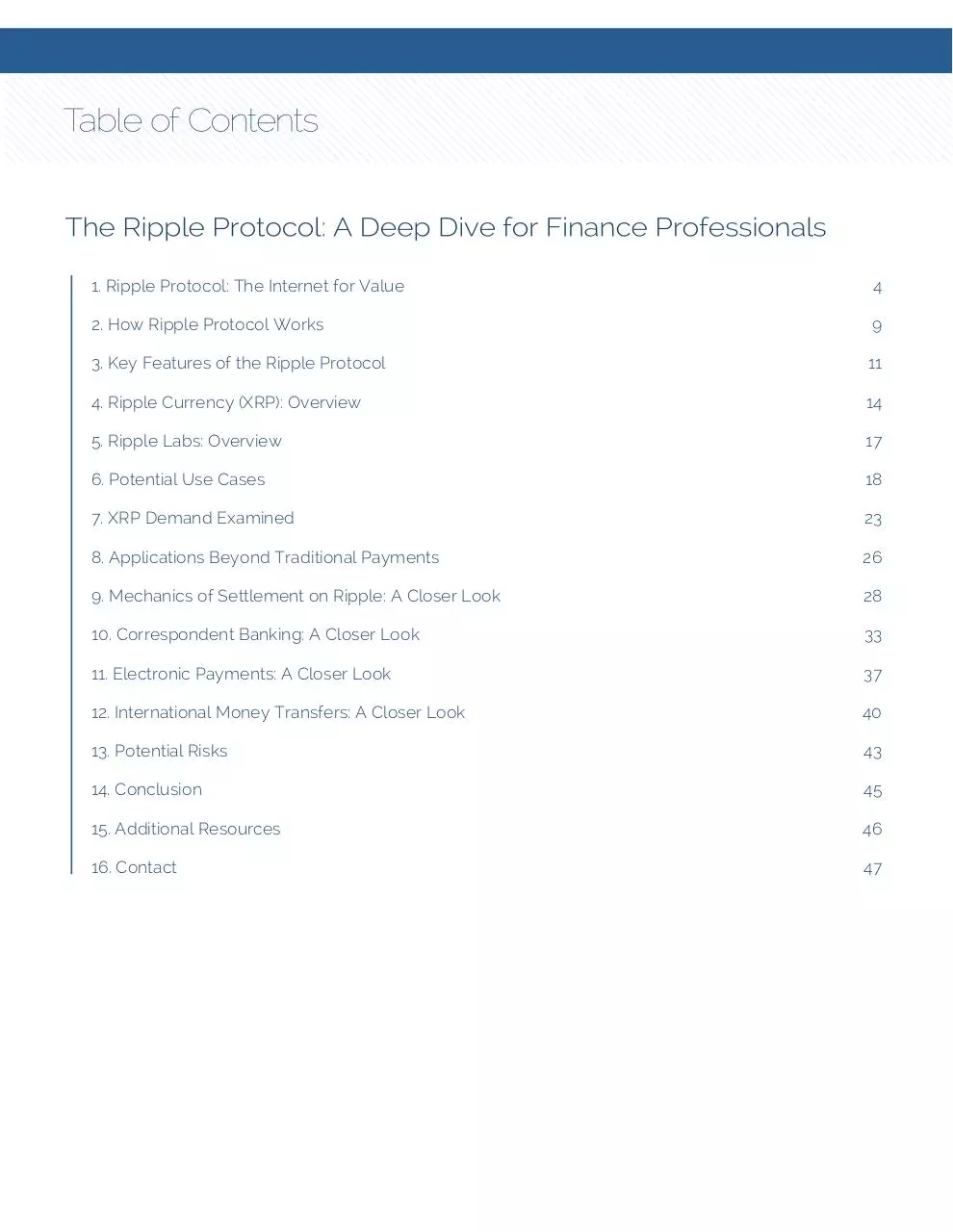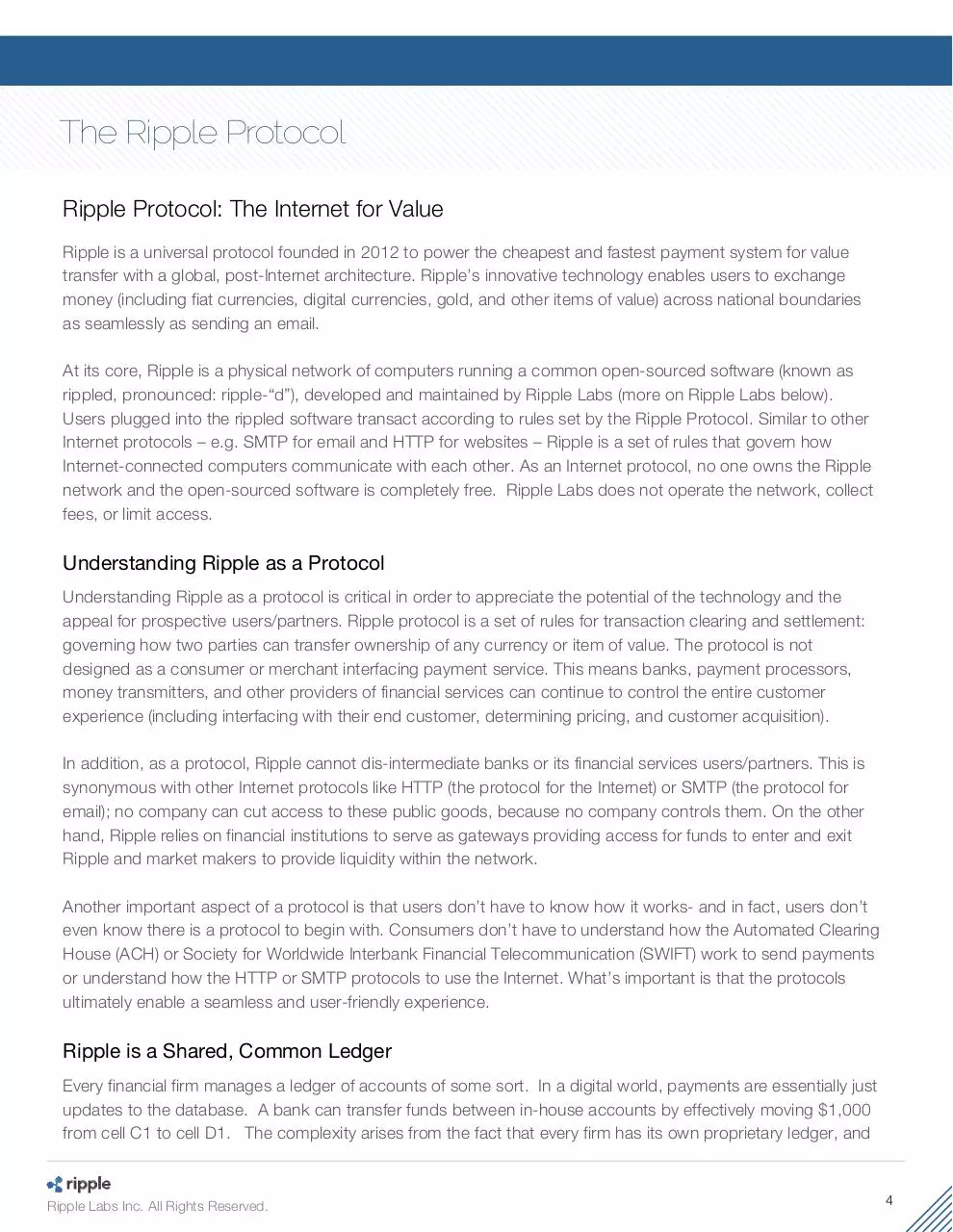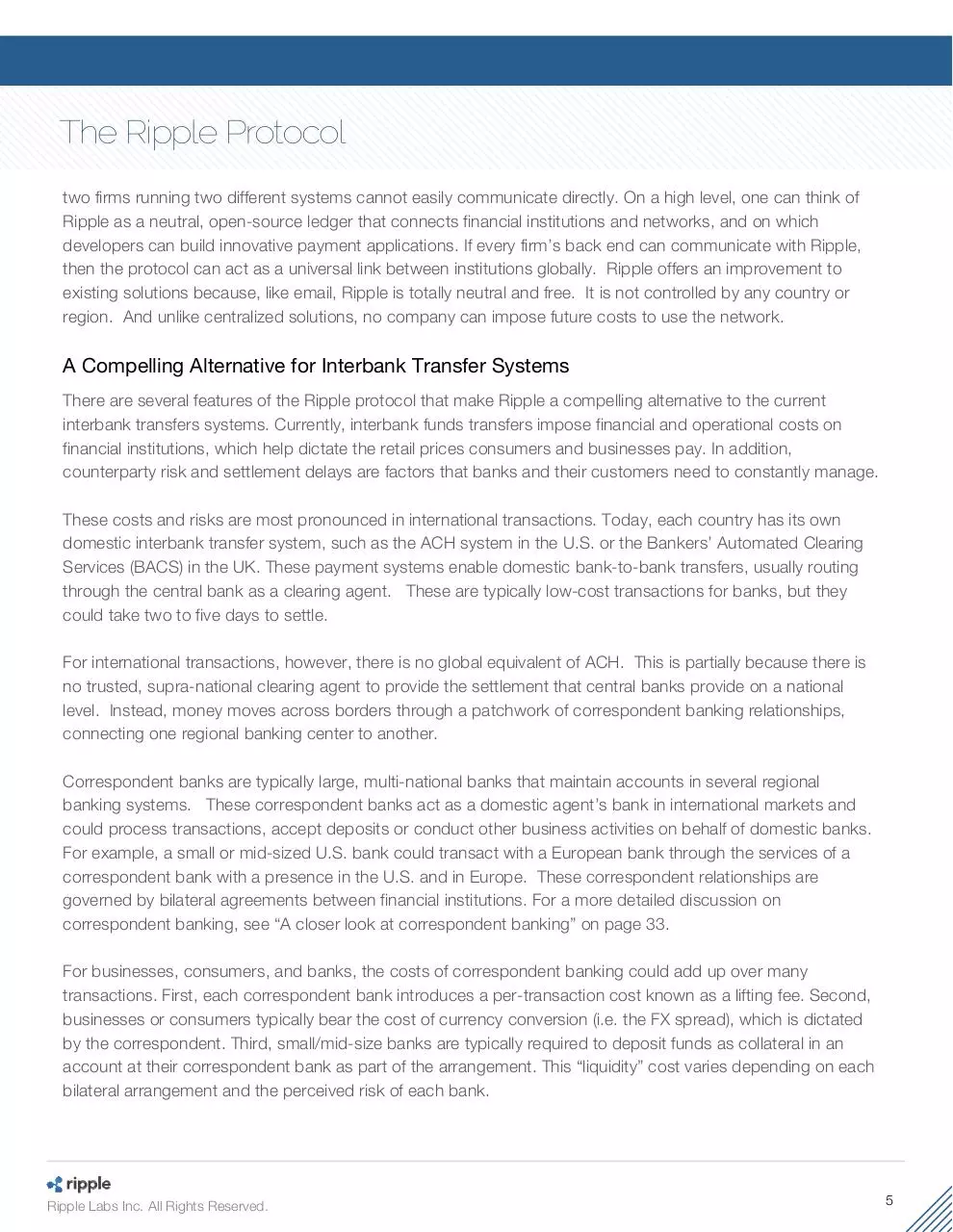Ripple Protocol Deep Dive For Financial Professionals (PDF)
File information
Title: Microsoft Word - Ripple_deep_dive_draft.docx
This PDF 1.3 document has been generated by Word / Mac OS X 10.10 Quartz PDFContext, and has been sent on pdf-archive.com on 05/03/2018 at 17:32, from IP address 67.87.x.x.
The current document download page has been viewed 1364 times.
File size: 4.9 MB (47 pages).
Privacy: public file





File preview
November 2014
Ripple Protocol: The Internet for Value
Ripple is a universal protocol founded in 2012 to power the cheapest and fastest payment system for value
transfer. Ripple’s technology enables users to transfer funds (including fiat currencies, digital currencies and
other forms of value) across national boundaries as seamlessly as sending an email.
Building Upon Other Digital Currencies
Like other digital currencies such as Bitcoin, the Ripple Protocol enables peer-to-peer transaction settlement
across a decentralized network of computers. As a result, Ripple circumvents many of the fees and reduces
many of the risks involved in interbank funds transfers, particularly in international transactions. Unlike other
digital currency protocols, however, the Ripple Protocol is currency agnostic and users are not required to
transact in the Protocol’s native currency (XRP). In addition, the technology enables near real-time settlement
(three to six seconds) and is built to route each international transaction to the cheapest FX bid/ask spread
available in the network.
A Compelling Alternative to Correspondent Banking
As a result of its key features, the Ripple Protocol represents a compelling alternative to traditional interbank
funds transfer systems. While this report walks through several potential applications of the protocol, the
technology is perhaps most promising in international transactions. Given the absence of an international
payment rail, international interbank funds transfers rely on a series of correspondent banking networks which
introduce multiple layers of fees, counterparty risk and settlement delays. The Ripple Protocol eliminates the
costs associated with correspondent banking as it enables two banks located anywhere in the world to
transact directly on a real-time basis.
Partnerships are Key
Another key differentiator of Ripple is the network’s reliance on partnerships with banks, payment processors,
money transmitters, and other financial services institutions. This approach stands in contrast to other peer-topeer networks, most of which seek to disintermediate existing players. The Ripple Protocol is not built to
interface directly with consumers and does not govern retail prices. Thus, the Protocol provides financial
institutions with the flexibility of passing on some of the cost savings to their end customers (consumers and
businesses) while managing profit margins.
Regulation, Liquidity and Competition are Key Risks
Regulatory uncertainty remains the key hurdle for digital currencies, including Ripple. It is unclear how
regulation will ultimately shape up and what costs this will add on the protocol or to its users. Additionally,
much of the protocol’s appeal, such as the ability to send funds abroad and leverage competitive FX rates,
hinges on the network ability to scale volume. Finally, competition could intensify as some incumbents that feel
threatened by the rise of digital currencies could enact policies to restrict adoption.
Ripple Labs Inc. All Rights Reserved.
1. Ripple Protocol: The Internet for Value
4
2. How Ripple Protocol Works
9
3. Key Features of the Ripple Protocol
11
4. Ripple Currency (XRP): Overview
14
5. Ripple Labs: Overview
17
6. Potential Use Cases
18
7. XRP Demand Examined
23
8. Applications Beyond Traditional Payments
26
9. Mechanics of Settlement on Ripple: A Closer Look
28
10. Correspondent Banking: A Closer Look
33
11. Electronic Payments: A Closer Look
37
12. International Money Transfers: A Closer Look
40
13. Potential Risks
43
14. Conclusion
45
15. Additional Resources
46
16. Contact
47
Ripple Protocol: The Internet for Value
Ripple is a universal protocol founded in 2012 to power the cheapest and fastest payment system for value
transfer with a global, post-Internet architecture. Ripple’s innovative technology enables users to exchange
money (including fiat currencies, digital currencies, gold, and other items of value) across national boundaries
as seamlessly as sending an email.
At its core, Ripple is a physical network of computers running a common open-sourced software (known as
rippled, pronounced: ripple-“d”), developed and maintained by Ripple Labs (more on Ripple Labs below).
Users plugged into the rippled software transact according to rules set by the Ripple Protocol. Similar to other
Internet protocols – e.g. SMTP for email and HTTP for websites – Ripple is a set of rules that govern how
Internet-connected computers communicate with each other. As an Internet protocol, no one owns the Ripple
network and the open-sourced software is completely free. Ripple Labs does not operate the network, collect
fees, or limit access.
Understanding Ripple as a Protocol
Understanding Ripple as a protocol is critical in order to appreciate the potential of the technology and the
appeal for prospective users/partners. Ripple protocol is a set of rules for transaction clearing and settlement:
governing how two parties can transfer ownership of any currency or item of value. The protocol is not
designed as a consumer or merchant interfacing payment service. This means banks, payment processors,
money transmitters, and other providers of financial services can continue to control the entire customer
experience (including interfacing with their end customer, determining pricing, and customer acquisition).
In addition, as a protocol, Ripple cannot dis-intermediate banks or its financial services users/partners. This is
synonymous with other Internet protocols like HTTP (the protocol for the Internet) or SMTP (the protocol for
email); no company can cut access to these public goods, because no company controls them. On the other
hand, Ripple relies on financial institutions to serve as gateways providing access for funds to enter and exit
Ripple and market makers to provide liquidity within the network.
Another important aspect of a protocol is that users don’t have to know how it works- and in fact, users don’t
even know there is a protocol to begin with. Consumers don’t have to understand how the Automated Clearing
House (ACH) or Society for Worldwide Interbank Financial Telecommunication (SWIFT) work to send payments
or understand how the HTTP or SMTP protocols to use the Internet. What’s important is that the protocols
ultimately enable a seamless and user-friendly experience.
Ripple is a Shared, Common Ledger
Every financial firm manages a ledger of accounts of some sort. In a digital world, payments are essentially just
updates to the database. A bank can transfer funds between in-house accounts by effectively moving $1,000
from cell C1 to cell D1. The complexity arises from the fact that every firm has its own proprietary ledger, and
Ripple Labs Inc. All Rights Reserved.
4
two firms running two different systems cannot easily communicate directly. On a high level, one can think of
Ripple as a neutral, open-source ledger that connects financial institutions and networks, and on which
developers can build innovative payment applications. If every firm’s back end can communicate with Ripple,
then the protocol can act as a universal link between institutions globally. Ripple offers an improvement to
existing solutions because, like email, Ripple is totally neutral and free. It is not controlled by any country or
region. And unlike centralized solutions, no company can impose future costs to use the network.
A Compelling Alternative for Interbank Transfer Systems
There are several features of the Ripple protocol that make Ripple a compelling alternative to the current
interbank transfers systems. Currently, interbank funds transfers impose financial and operational costs on
financial institutions, which help dictate the retail prices consumers and businesses pay. In addition,
counterparty risk and settlement delays are factors that banks and their customers need to constantly manage.
These costs and risks are most pronounced in international transactions. Today, each country has its own
domestic interbank transfer system, such as the ACH system in the U.S. or the Bankers’ Automated Clearing
Services (BACS) in the UK. These payment systems enable domestic bank-to-bank transfers, usually routing
through the central bank as a clearing agent. These are typically low-cost transactions for banks, but they
could take two to five days to settle.
For international transactions, however, there is no global equivalent of ACH. This is partially because there is
no trusted, supra-national clearing agent to provide the settlement that central banks provide on a national
level. Instead, money moves across borders through a patchwork of correspondent banking relationships,
connecting one regional banking center to another.
Correspondent banks are typically large, multi-national banks that maintain accounts in several regional
banking systems. These correspondent banks act as a domestic agent’s bank in international markets and
could process transactions, accept deposits or conduct other business activities on behalf of domestic banks.
For example, a small or mid-sized U.S. bank could transact with a European bank through the services of a
correspondent bank with a presence in the U.S. and in Europe. These correspondent relationships are
governed by bilateral agreements between financial institutions. For a more detailed discussion on
correspondent banking, see “A closer look at correspondent banking” on page 33.
For businesses, consumers, and banks, the costs of correspondent banking could add up over many
transactions. First, each correspondent bank introduces a per-transaction cost known as a lifting fee. Second,
businesses or consumers typically bear the cost of currency conversion (i.e. the FX spread), which is dictated
by the correspondent. Third, small/mid-size banks are typically required to deposit funds as collateral in an
account at their correspondent bank as part of the arrangement. This “liquidity” cost varies depending on each
bilateral arrangement and the perceived risk of each bank.
Ripple Labs Inc. All Rights Reserved.
5
Moreover, each correspondent banking relationship introduces settlement delays, and the more complicated a
correspondent banking network gets for a particular funds transfer, the longer the businesses and consumers
need to wait to access funds. This could place small and mid-size banks at a disadvantage competing with
larger peers who can often provide a better customer experience for international transactions
Inefficiencies in International Funds Transfers
The following is a simple illustrative example of how an international payment
from a U.S. account holder (say, a U.S. importing business) to a EU account
holder (say, a German exporting business) is handled through correspondent
banking channels. The example below illustrates how the funds move after
the U.S. account holder initiates the payment.
If the U.S. Bank does not have an EU banking license, which is typical of
most small and mid-sized banks, then the U.S. Bank first transfers the funds
to a large U.S. bank, its domestic correspondent bank. However, given that
these banks operate different core account ledgers, they are unable to
transact directly. Thus, the U.S. Bank routes the funds through the Federal
Reserve, which then relays the funds to the domestic correspondent bank.
These funds are transferred via the ACH system.
The correspondent bank maintains an account in the EU banking system,
known as a nostro account, which is pre-funded with euros. After receiving
USD funds via ACH, the domestic correspondent bank then initiates an
offsetting EUR transfer from its nostro account to the beneficiary’s bank in the
EU banking system. Again, given that these EU banks also operate different
account ledgers, the EU correspondent bank needs to route the funds via the
European Central Bank, which acts as a clearing agent and finally relays the
funds to the European bank where the German exporting business has an
account.
Ripple Labs Inc. All Rights Reserved.
SWIFT: Messaging vs. Funds
Transfer
The Society for Worldwide
Interbank Financial
Telecommunication (SWIFT)
provides a network that
enables financial institutions
worldwide to send and receive
information about financial
transactions in a secure,
standardized and reliable
environment.
SWIFT is often colloquially
thought of as “international
wire.” However, it only
provides for messaging and
does not provide for funds
settlement.
Settlement still occurs through
a patchwork of regional rails.
Ripple can provide a free,
international rail that can coexist with SWIFT messages.
6
A key takeaway here is that there is no direct linkage between the U.S. and EU banking systems save for a
handful of multi-national correspondent banks that maintain funded accounts in both regions and charge for
the service of effecting funds transfer between them.
International transactions need to go through a series of hops between domestic banks, central banks and
correspondent banks. Each hop represents an additional layer of cost (usually a per transaction fee), risk
(settlement and counterparty risk), and delay. Additionally, international transactions introduce FX conversion
fees (for businesses/consumers) and currency reserve management costs (for banks). The diagram below, for
all its complexity, shows a relatively simply example between two heavily trafficked regions/currencies. The
path between two developing market regions can be significantly more complex and costly, and in some
cases, non-existent.
Sent:
$1000
(€760)
$7.5
fee
Received:
€720
($940)
$25
fee
4%
FX
€15
fee
The Double-Spend Problem: Bitcoin’s Breakthrough
Transaction settlement has historically been a tri-party arrangement between the sender, the beneficiary, and a
trusted third party clearing agent. For example, in the U.S., the Federal Reserve is the trusted clearing agent
that operates a ledger shared between banks. In retail payments, a player like PayPal is a clearing agent that
operates a ledger shared by its retail users.
The need for a clearing agent stems from what technologists refer to as the double spending problem. A digital
USD balance is just an entry in a ledger. It is the liability of its issuer – a promise to pay the bearer on demand
– and it is underpinned by the assets held by a bank or custodian.
Without the Federal Reserve acting as a trusted clearing agent, a bank could conceivably “double spend” its
assets and simultaneously send payments to multiple counterparties, which presents significant counterparty
risk. Instead, banks deposit funds with the Federal Reserve, and the Fed can move assets between their
accounts with enough visibility to ensure the solvency of payments. Or in the retail example, users deposit
funds with Paypal, and Paypal can ensure that a user’s assets are not double spent.
Ripple Labs Inc. All Rights Reserved.
7
The Bitcoin protocol offered a novel solution to the double spend problem. In the Bitcoin protocol, a network
of interconnected computers collectively managed a ledger which tracks ownership of digital assets (bitcoins).
This eliminated the need for a clearing agent, thus enabling the peer-to-peer transfer of funds with no
intermediaries. This theoretically eliminates many of the fees and underlying counterparty risk.
However, the Bitcoin protocol - like most other digital currency protocols - requires users to transact in the
protocol’s native digital currency (i.e. Bitcoin users must transact in bitcoins, or BTC).
The exhibit below illustrates how the same U.S. importer business can transfer funds to the German exporter
business via the Bitcoin protocol. First, the U.S. business converts USD into BTC using a bitcoin service
provider. BTC can then be transferred directly to the beneficiary’s bitcoin account. Next, the German
business service provider converts the BTC into Euros, and finally, the bitcoin service provider delivers Euros to
the German business. The German business then deposits the amount into its EU Bank.
Bitcoin’s technology is a conceptual improvement that removes much of the friction in the current process for
interbank transfers. The protocol enables peer-to-peer transaction settlement and thus circumvents the
complicated and costly correspondent banking framework. This has the potential to provide users with both
cost savings and faster settlement. However, the fact that the Bitcoin protocol requires users to transact in
BTC introduces some new frictions:
•
•
•
•
Exchanges or bitcoin payment processors impose transaction fees to convert in and out of bitcoin.
Liquidity to convert in and out of BTC may be limited or costly.
Though many users immediately convert out of BTC upon receipt, there is still ten to sixty minutes of
currency volatility that is unavoidable while the bitcoin network confirms transactions. YTD, the
average hourly trading range for BTC/USD has been 1.5% with outlier moves as high as 20% over a
sixty-minute window. This volatility can entirely consume the savings of using bitcoin, and then
some.
Even if the volatility of BTC is significantly reduced, there is no way to guarantee the fiat value that
the beneficiary will receive (without a third party taking the price risk) which presents challenges for
this schema to comply with Consumer Financial Protection Bureau mandates.
Ripple Labs Inc. All Rights Reserved.
8
How Ripple Works
The Ripple protocol builds upon – and in some ways improves on – other digital currencies. Like other digital
currencies, the Ripple protocol enables peer-to-peer transaction settlement through a decentralized network of
interconnected computers. This eliminates several of the fees and counterparty risk involved in interbank fund
transfers.
However, in contrast to other digital currencies, the Ripple protocol is completely currency agnostic and users
are not required to convert local currency into Ripple’s native currency (XRP or “ripples”). Additionally, rather
than attempt to circumvent traditional financial institutions, Ripple relies on financial institutions to function as
(1) gateways into and out of the Ripple network, and (2) market makers to provide liquidity for FX conversion by
posting bids/asks for each currency pair. Ripple routes each transaction to the trader(s) with the best price in
the network.
Thus, in the same transaction discussed above, the U.S. importer’s bank would directly plug into Ripple and
initiate a USD to EUR transaction. Market makers will compete for the transaction by posting bid/ask for
EUR/USD. Ripple will ensure the market maker posting the cheapest offer fulfills the transaction. This market
maker will thus, buy USD from U.S. Bank and sell Euros to the EU Bank.
The illustrative example points to several potential advantages of using the Ripple Protocol for interbank
transfers.
• First, because, users are not required to convert to XRP in order to transact on the Protocol, the
sender of the funds only needs to worry about one fee, which is the FX spread. This spread,
moreover, is minimized given Ripple’s algorithm to route transactions to the lowest spread on the
network.
• Second, because Ripple is not intended to be directly customer interfacing, banks continue to
control their customers’ experience. Thus, banks could ultimately decide how much of the cost
savings to pass on to their customers.
• Third, transactions on the Ripple network typically settle within a few seconds. This enables banks to
grant their customers faster access to their funds, improving their overall customer experience, and
improving working capital for businesses.
Ripple Labs Inc. All Rights Reserved.
9
Download Ripple Protocol - Deep Dive For Financial Professionals
Ripple Protocol - Deep Dive For Financial Professionals.pdf (PDF, 4.9 MB)
Download PDF
Share this file on social networks
Link to this page
Permanent link
Use the permanent link to the download page to share your document on Facebook, Twitter, LinkedIn, or directly with a contact by e-Mail, Messenger, Whatsapp, Line..
Short link
Use the short link to share your document on Twitter or by text message (SMS)
HTML Code
Copy the following HTML code to share your document on a Website or Blog
QR Code to this page

This file has been shared publicly by a user of PDF Archive.
Document ID: 0000741640.